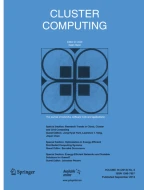Abstract
In wireless communication networks, one of the most significant problems in Compute-and-Forward (CPF) strategy based on Integer-Forcing (IF) technique is to search the optimal integer coefficient vector for a relay to decode the received messages. While this is a variant of shortest vector problem (SVP), which is prohibitively complex in its general form. In this paper, we mainly focus on the optimal integer solution with non-zero entries in multi-source one-relay model. For comparison we extend the number (or dimension) of communication nodes from 2 to any larger integer n based on an existing 2-dimensional search algorithm with non-zero entries. Then we add this non-zero-entries constraint to an existing search algorithm and make some improvements to search the optimal integer vector by solving an optimization problem over only one variable instead of searching all vector components, which has a much lower time complexity. We prove that our new search algorithm is more efficient with polynomial complexity compared with the extended n-dimensional algorithm, meanwhile the same optimal integer solution is guaranteed.


Similar content being viewed by others
References
Nazer, B., Gastpar, M.: Compute-and-forward: Harnessing interfer-ence through structured codes. IEEE Trans. Inf. Theory. 57, 6463–6486 (2011)
Nazer, B., Gastpar, M.: Reliable physical layer network coding. Proc. IEEE. 99, 438–460 (2011)
Zamir, R.: Lattices are everywhere. In: Proceedings of the 4th Annual Workshop on Information Theory and its Applications, pp. 392–421 (2009)
Wen, J., Chang, X.W.: Success probability of the Babai estimators for box-constrained integer linear models. IEEE Trans. Inf. Theory. 63, 631–648 (2017)
Erez, U., Zamir, R.: Achieving (1/2)log(1+SNR) on the AWGN channel with lattice encoding and decoding. IEEE Trans. Inf. Theory. 50, 2293–2314 (2004)
Ahlswede, R., Cai, N., Li, S.Y., Yeung, R.W.: Network information flow. IEEE Trans. Inf. Theory. 46, 1204–1216 (2000)
Koetter, R., Mdard, M.: Beyond routing: an algebraic approach to network coding. IEEE/ACM Trans. Netw. 11, 782–795 (2003)
Wieselthier, J.E., Nguyen, G.D., Ephremides, A.: Energy-efficient multicasting of session traffic in bandwidth- and transceiver-limited wireless networks. Clust. Comput. 5, 179–192 (2002)
Wen, J., Li, D., Zhu, F.: Stable Recovery of Sparse Signals via lp-Minimization. Appl. Comput. Harmon. Anal. 38, 161–176 (2015)
Zhan, J., Nazer, B., Erez, U., Gastpar, M.: Integer-forcing linear receivers. IEEE Trans. Inf. Theory. 60, 7661–7685 (2014)
Zhan, J., Nazer, B., Erez, U., Gastpar, M.: Integer-forcing linear receivers: a new low-complexity MIMO architecture. In: IEEE Vehicular Technology Conference Fall (VTC 2010-Fall), pp. 1–5 (2010)
Dadush, D., Peikert, C., Vempala, S.: Enumerative lattice algorithms in any norm via m-ellipsoid coverings. In: IEEE 52nd Annual Symposium on FOCS, pp. 580–589 (2011)
Dadush, D., Micciancio, D.: Algorithms for the densest sub-lattice problem. SODA. SIAM. 1103-1122 (2013)
Alekhnovich, M., Khot, S.A., Kindler, G., Vishnoi, N.K.: Hardness of approximating the closest vector problem with preprocessing. In: 46th Annual IEEE Symposium on FOCS, pp 216–225 (2005)
Pappi, K.N., Diamantoulakis, P.D., Otrok, H., Karagiannidis, G.K.: Cloud compute-and-forward with relay cooperation. IEEE Trans. Wireless Commun. 14, 3415–3428 (2015)
Wei, L., Chen, W.: Compute-and-forward network coding design over multi-source multi-relay channels. IEEE Trans. Wireless Commun. 11, 3348–3357 (2012)
Chen, Z., Fan, P.Y., Letaief, K.B.: Compute-and-forward: optimization over multisourcecmultirelay networks. IEEE Trans. Veh. Technol. 64, 1806–1818 (2015)
Wei, L., Chen, W.: Efficient compute-and-forward network codes search for two-way relay channel. IEEE Commun. Lett. 16, 1204–1207 (2012)
Shukla, S., Muralidharan, V.T., Rajan, B.: Wireless network-coded accumulate-compute and forward two-way relaying. IEEE Trans. Veh. Technol. 65, 1367–1381 (2016)
Fincke, U., Pohst, M.: Improved methods for calculating vectors of short length in a lattice, including a complexity analysis. Math. Comput. 44, 463–471 (1985)
Sahraei, S., Gastpar, M.: Compute-and-forward: finding the best equation. In: 52nd Annual Allerton Conference on Communication, Control, and Computing, pp. 227–233 (2014)
Acknowledgements
This work was supported by the National Natural Science Foundation of China (61472024, U1433203), Development Program for Distinguished Young Teachers in Higher Education of Guangdong Province (Grant No. Yq2013147).
Author information
Authors and Affiliations
Corresponding author
Rights and permissions
About this article
Cite this article
Tong, C., Li, J. & Wen, J. A polynomial time algorithm for a variant of shortest vector problem with applications in compute-and-forward design. Cluster Comput 22 (Suppl 5), 10415–10424 (2019). https://doi.org/10.1007/s10586-017-1032-z
Received:
Revised:
Accepted:
Published:
Issue Date:
DOI: https://doi.org/10.1007/s10586-017-1032-z



